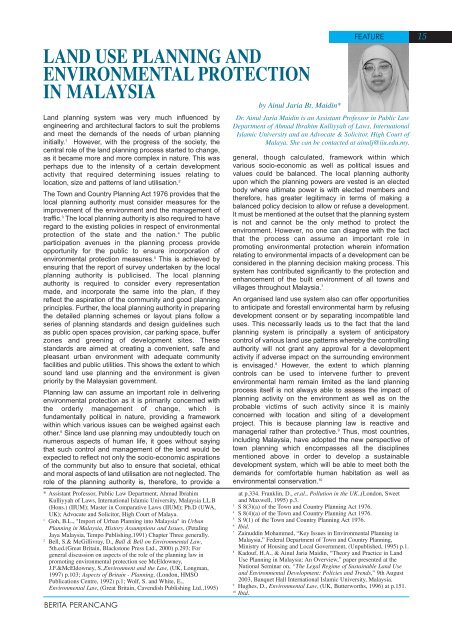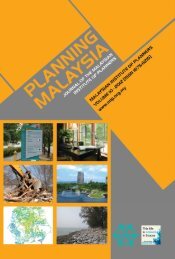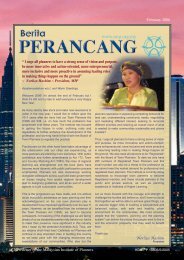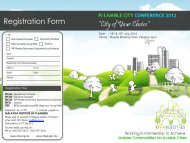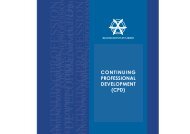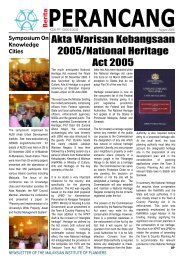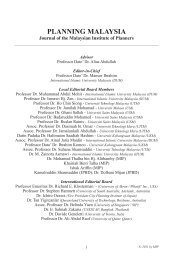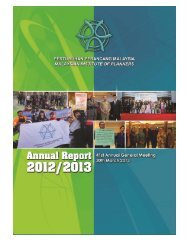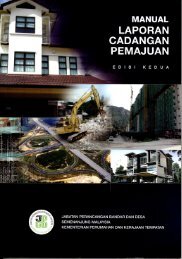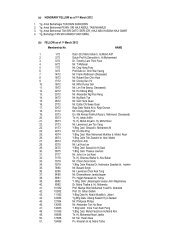Download November 2005 Issue - Malaysian Institute of Planners
Download November 2005 Issue - Malaysian Institute of Planners
Download November 2005 Issue - Malaysian Institute of Planners
Create successful ePaper yourself
Turn your PDF publications into a flip-book with our unique Google optimized e-Paper software.
LAND USE PLANNING ANDENVIRONMENTAL PROTECTIONIN MALAYSIAby Ainul Jaria Bt. Maidin*Land planning system was very much influenced byengineering and architectural factors to suit the problemsand meet the demands <strong>of</strong> the needs <strong>of</strong> urban planninginitially. 1 However, with the progress <strong>of</strong> the society, thecentral role <strong>of</strong> the land planning process started to change,as it became more and more complex in nature. This wasperhaps due to the intensity <strong>of</strong> a certain developmentactivity that required determining issues relating tolocation, size and patterns <strong>of</strong> land utilisation. 2The Town and Country Planning Act 1976 provides that thelocal planning authority must consider measures for theimprovement <strong>of</strong> the environment and the management <strong>of</strong>traffic. 3 The local planning authority is also required to haveregard to the existing policies in respect <strong>of</strong> environmentalprotection <strong>of</strong> the state and the nation. 4 The publicparticipation avenues in the planning process provideopportunity for the public to ensure incorporation <strong>of</strong>environmental protection measures. 5 This is achieved byensuring that the report <strong>of</strong> survey undertaken by the localplanning authority is publicised. The local planningauthority is required to consider every representationmade, and incorporate the same into the plan, if theyreflect the aspiration <strong>of</strong> the community and good planningprinciples. Further, the local planning authority in preparingthe detailed planning schemes or layout plans follow aseries <strong>of</strong> planning standards and design guidelines suchas public open spaces provision, car parking space, bufferzones and greening <strong>of</strong> development sites. Thesestandards are aimed at creating a convenient, safe andpleasant urban environment with adequate communityfacilities and public utilities. This shows the extent to whichsound land use planning and the environment is givenpriority by the <strong>Malaysian</strong> government.Planning law can assume an important role in deliveringenvironmental protection as it is primarily concerned withthe orderly management <strong>of</strong> change, which isfundamentally political in nature, providing a frameworkwithin which various issues can be weighed against eachother. 6 Since land use planning may undoubtedly touch onnumerous aspects <strong>of</strong> human life, it goes without sayingthat such control and management <strong>of</strong> the land would beexpected to reflect not only the socio-economic aspirations<strong>of</strong> the community but also to ensure that societal, ethicaland moral aspects <strong>of</strong> land utilisation are not neglected. Therole <strong>of</strong> the planning authority is, therefore, to provide a* Assistant Pr<strong>of</strong>essor, Public Law Department, Ahmad IbrahimKulliyyah <strong>of</strong> Laws, International Islamic University, Malaysia LL.B(Hons.) (IIUM); Master in Comparative Laws (IIUM); Ph.D (UWA,UK); Advocate and Solicitor, High Court <strong>of</strong> Malaya.1Goh, B.L., "Import <strong>of</strong> Urban Planning into Malaysia" in UrbanPlanning in Malaysia, History Assumptions and <strong>Issue</strong>s, (PetalingJaya Malaysia, Tempo Publishing,1991) Chapter Three generally.2Bell, S.& McGillivray, D., Ball & Bell on Environmental Law,5th.ed.(Great Britain, Blackstone Press Ltd., 2000) p.293; Forgeneral discussion on aspects <strong>of</strong> the role <strong>of</strong> the planning law inpromoting environmental protection see McEldowney,J.F.&McEldowney, S.,Environment and the Law, (UK, Longman,1997) p.103; Aspects <strong>of</strong> Britain - Planning, (London, HMSOPublications Centre, 1992) p.1; Wolf, S. and White, E.,Environmental Law, (Great Britain, Cavendish Publishing Ltd.,1995)BERITA PERANCANGFEATURE 15Dr. Ainul Jaria Maidin is an Assistant Pr<strong>of</strong>essor in Public LawDepartment <strong>of</strong> Ahmad Ibrahim Kulliyyah <strong>of</strong> Laws, InternationalIslamic University and an Advocate & Solicitor, High Court <strong>of</strong>Malaya. She can be contacted at ainulj@iiu.edu.my.general, though calculated, framework within whichvarious socio-economic as well as political issues andvalues could be balanced. The local planning authorityupon which the planning powers are vested is an electedbody where ultimate power is with elected members andtherefore, has greater legitimacy in terms <strong>of</strong> making abalanced policy decision to allow or refuse a development.It must be mentioned at the outset that the planning systemis not and cannot be the only method to protect theenvironment. However, no one can disagree with the factthat the process can assume an important role inpromoting environmental protection wherein informationrelating to environmental impacts <strong>of</strong> a development can beconsidered in the planning decision making process. Thissystem has contributed significantly to the protection andenhancement <strong>of</strong> the built environment <strong>of</strong> all towns andvillages throughout Malaysia. 7An organised land use system also can <strong>of</strong>fer opportunitiesto anticipate and forestall environmental harm by refusingdevelopment consent or by separating incompatible landuses. This necessarily leads us to the fact that the landplanning system is principally a system <strong>of</strong> anticipatorycontrol <strong>of</strong> various land use patterns whereby the controllingauthority will not grant any approval for a developmentactivity if adverse impact on the surrounding environmentis envisaged. 8 However, the extent to which planningcontrols can be used to intervene further to preventenvironmental harm remain limited as the land planningprocess itself is not always able to assess the impact <strong>of</strong>planning activity on the environment as well as on theprobable victims <strong>of</strong> such activity since it is mainlyconcerned with location and siting <strong>of</strong> a developmentproject. This is because planning law is reactive andmanagerial rather than protective. 9 Thus, most countries,including Malaysia, have adopted the new perspective <strong>of</strong>town planning which encompasses all the disciplinesmentioned above in order to develop a sustainabledevelopment system, which will be able to meet both thedemands for comfortable human habitation as well asenvironmental conservation. 10at p.334. Franklin, D., et.al., Pollution in the UK.,(London, Sweetand Maxwell, 1995) p.3.3S 8(3)(a) <strong>of</strong> the Town and Country Planning Act 1976.4S 8(4)(a) <strong>of</strong> the Town and Country Planning Act 1976.5S 9(1) <strong>of</strong> the Town and Country Planning Act 1976.6Ibid.7Zainuddin Mohammed, “Key <strong>Issue</strong>s in Environmental Planning inMalaysia,” Federal Department <strong>of</strong> Town and Country Planning,Ministry <strong>of</strong> Housing and Local Government, (Unpublished, 1995) p.1.8Kadouf, H.A., & Ainul Jaria Maidin, “Theory and Practice in LandUse Planning in Malaysia: An Overview,” paper presented at theNational Seminar on, “The Legal Regime <strong>of</strong> Sustainable Land Useand Environmental Development: Policies and Trends,” 9th August2003, Banquet Hall International Islamic University, Malaysia.9Hughes, D., Environmental Law, (UK, Butterworths, 1996) at p.151.10Ibid.


